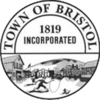Bristol, New Hampshire
| Bristol, New Hampshire | ||
|---|---|---|
| Town | ||

Central Square in 2012
|
||
|
||
| Motto: "The Gateway to Newfound Lake" | ||
 Location in Grafton County, New Hampshire |
||
| Coordinates: 43°35′28″N 71°44′12″W / 43.59111°N 71.73667°WCoordinates: 43°35′28″N 71°44′12″W / 43.59111°N 71.73667°W | ||
| Country | United States | |
| State | New Hampshire | |
| County | Grafton | |
| Incorporated | 1819 | |
| Government | ||
| • Board of Selectmen | Shaun Lagueux Rick Alpers JP Morrison Paul Manganiello Leslie Dion |
|
| • Town Administrator | Nik Coates | |
| Area | ||
| • Total | 22.4 sq mi (57.9 km2) | |
| • Land | 17.1 sq mi (44.3 km2) | |
| • Water | 5.3 sq mi (13.6 km2) 23.43% | |
| Elevation | 466 ft (142 m) | |
| Population (2010) | ||
| • Total | 3,054 | |
| • Density | 140/sq mi (53/km2) | |
| Time zone | Eastern (UTC-5) | |
| • Summer (DST) | Eastern (UTC-4) | |
| ZIP code | 03222 | |
| Area code(s) | 603 | |
| FIPS code | 33-07700 | |
| GNIS feature ID | 0873552 | |
| Website | www |
|
Bristol is a town in Grafton County, New Hampshire, United States. The population was 3,054 at the 2010 census. It is home to Wellington State Park, Sugar Hill State Forest, and Profile Falls on the Smith River. Surrounded by hills and lakes, Bristol includes the lower two-thirds of Newfound Lake, a resort area.
The primary settlement in town, where 1,688 people resided at the 2010 census, is defined by the U.S. Census Bureau as the Bristol census-designated place (CDP) and is located at the intersection of New Hampshire routes 3A and 104.
Bristol was taken from Bridgewater and New Chester (now Hill) and incorporated 24 June 1819. Colonel Peter Sleeper, Benjamin Emmons and others commenced a settlement here in 1770.
Extensive deposits of fine sand or clay similar to the "Bristol sand" used in Bristol, England, to make fine china and pottery gave the town its name. Here the sand was used to make a superior quality brick, marketed as Bristol brick. With water power from the Pemigewasset River, the town was a center of manufacturing in the early days for goods such as paper, leather, woolens, flannel, bedsteads and piano stools.
...
Wikipedia

